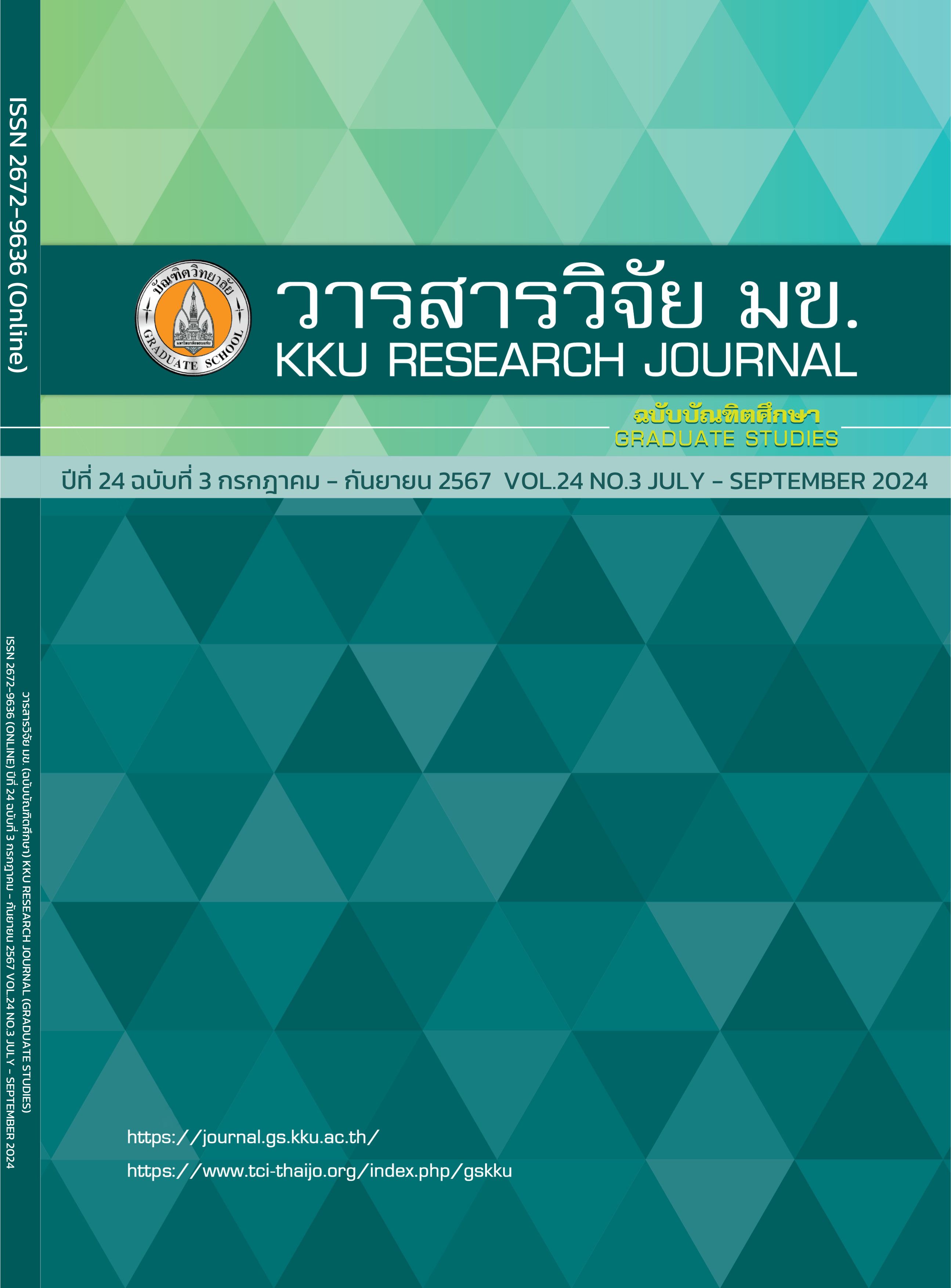A Low-cost Electrochemical Biosensor With Copper and Aluminum Electrodes for Alcohol Detection
Keywords:
Paper-based biosensor, Electrochemical biosensor, Alcohol measurementAbstract
Drunk driving is one of the leading causes of traffic accidents worldwide. This research aimed to develop a low-cost paper-based electrochemical biosensor for alcohol concentration measurement utilizing an alcohol oxidation reaction catalyzed by the alcohol oxidase enzyme. The anode and cathode electrodes of the paper-based biosensor were made of copper and aluminum tapes, respectively, and were coupled to electronic sensor modules for signal reading and processing. The results demonstrated that the oxidase enzyme was necessary for the biosensor to function, resulting in a linear signal response with alcohol concentrations ranging from 9 to 36 mM. The sensitivity of the enzyme-coated biosensor was significantly higher than that of the enzyme-free biosensor. Moreover, measuring the biosensor’s electrochemical signal by current was found to yield a higher sensitivity (0.5499 – 1.0915 μA/mM) than voltage measurements (0.0010 – 0.0022 V/mM). The maximum sensitivity of 1.0915 μA/mM (R2 = 0.8410) was obtained by measuring the current near the reaction zone at the center of the biosensor sheet. The optimum enzyme concentration that gave rise to the maximum sensitivity was found to be 20% v/v with a detection limit of 1.9478 mM. The biosensor was estimated to cost approximately 12 baht, considerably cheaper than the current breathalyzer-based method, and could therefore be further developed as a portable, disposable alcohol test pad to prevent drunk driving accidents.
References
The Office of Transport and Traffic Policy and planning. Road Accident Situation Analysis Report of the Ministry of Transport 2019 [online] 2019 [cited 2022 sep. 20]. Available from: https://www.otp.go.th/index.php/post/view?id=3995&id=3995. Thai.
Accident Reduction Network Office. Traffic Accident Statistics Report, New Year - Songkran Festival 2017 [online] 2560 [cited 2022 sep. 20]. Available from: http://www.accident.or.th/index.php/2017-12-04-07-32-28/56-2560. Thai.
Samajarn J. alcohol-induced brain damage [online] 2562 2019 [cited 2022 sep. 20]. Available from: https://www.samitivejhospitals.com. Thai.
Chonumpai V, Rujirojkul W. Blood Alcohol Concentration and Road Traffic Accident in Eastern Economic Corridor, 2017. Thai journal of toxicology. 2019; 34(1): 9-19. Thai.
Sreeganjant P. A Comparative Study of the Ethyl Alcohol Concentration in Vitreous Humor and Blood with Headspace Gas Chromatography. Journal of Criminology and Forensic Science 2019 6(1): 48-58. Thai.
Khemtonglang K, Chaiyaphet N, Kumsaen T, Chaiyachati C, Chuchuen O. A Smart Wristband Integrated with an IoT-Based Alarming System for Real-Time Sweat Alcohol Monitoring. Sensors. 2022; 22(17): 6435.
Li B, Downen RS, Dong Q, Tran N, LeSaux M, Meltzer AC, et al. A Discreet Wearable IoT Sensor for Continuous Transdermal Alcohol Monitoring - Challenges and Opportunities. IEEE Sensors Journal 2021; 21(4): 5322-5330.
Kim J, Jeerapan I, Imani S, Cho TN, Bandodkar A, Cinti S, et al. Noninvasive Alcohol Monitoring Using a Wearable Tattoo-Based Iontophoretic-Biosensing System. ACS Sensors 2016; 1(8): 1011-1019.
Bhide A, Muthukumar S, Prasad S. CLASP (Continuous lifestyle awareness through sweat platform): A novel sensor for simultaneous detection of alcohol and glucose from passive perspired sweat. Biosens Bioelectron 2018; 117: 537-545.
Liu Y, Chen JY. Enzyme immobilization on cellulose matrixes. Journal of Bioactive and Compatible Polymers. 2016; 31(6): 553-567.
Martinez AW, Phillips ST, Whitesides GM, Carrilho E. Diagnostics for the Developing World: Microfluidic Paper-Based Analytical Devices. Analytical Chemistry. 2010; 82(1): 3-10.
Chen S-F, Danao M-G. Predictive models of ethanol concentrations in simulated exhaled breath and exhaled breath condensate under varied sampling conditions. Journal of Biomedical Science and Engineering. 2013; 6: 788-795.
Sabzkoohi HA, Dodier V, Kolliopoulos G. A validated analytical method to measure metals dissolved in deep eutectic solvents. RSC Adv. 2023; 13(22): 14887-14898.
AVIA Semiconductor. 24-Bit Analog-to-Digital Converter (ADC) for Weigh Scales [online] n.d. [cited 2023 sep. 18]. Available from: http:// www.alldatasheet.com/view.jsp?Searchword=HX711&sField=4
Mixed Signal and DSP Design Techniques, W.Kester, Editor. Elsevier, Burlington; 2002
Bethea R, Rhinehart RR. Applied Engineering Statistics. Technometrics. 1994; 36.
Kelly JD, Hedengren JD. A steady-state detection (SSD) algorithm to detect non-stationary drifts in processes. Journal of Process Control. 2013; 23(3): 326-31.
Ifko D, Vasić K, Knez Ž, Leitgeb M. (Magnetic) Cross-Linked Enzyme Aggregates of Cellulase from T. reesei: A Stable and Efficient Biocatalyst. Molecules [Internet]. 2023 Jan 30; 28(3): 1305. Available from: http://dx.doi.org/10.3390/molecules28031305
Schwartz RH, O'Donnell RM, Thorne MM, Getson PR, Hicks JM. Evaluation of colorimetric dipstick test to detect alcohol in saliva: A pilot study. Annals of Emergency Medicine. 1989; 18(9): 1001-1003.
Kaewnu K, Promsuwan K, Phonchai A, Thiangchanya A, Somapa D, Somapa N, et al. Cost-Effective Foam-Based Colorimetric Sensor for Roadside Testing of Alcohol in Undiluted Saliva. Chemosensors .2021; 9(12).
Mustafa F, Carhart M, Andreescu S. A 3D-Printed Breath Analyzer Incorporating CeO2 Nanoparticles for Colorimetric Enzyme-Based Ethanol Sensing. ACS Applied Nano Materials. 2021; 4(9): 9361-9369.
Downloads
Published
Issue
Section
License
Copyright (c) 2024 KKU Research Journal (Graduate Studies)

This work is licensed under a Creative Commons Attribution-NonCommercial-NoDerivatives 4.0 International License.



